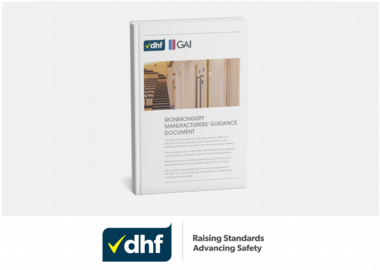
The Door & Hardware Federation (DHF) and the Guild of Architectural Ironmongers (GAI) have announced the publication of the Ironmongery Manufacturers’ Guidance Document – a new, industry-led best practice guide created to support manufacturers in providing clear, consistent and comprehensive product information for fire door hardware being placed on the market in Great Britain.
Developed over the course of more than a year through collaborative working between GAI, DHF and the Office for Product Safety and Standards (OPSS), this document addresses a crucial area of fire safety and product compliance.
It has been specifically created to help manufacturers, distributors and those applying their own branding to ironmongery products understand their obligations and provide the information necessary to support safe and effective product selection, installation and ongoing maintenance.
Duncan Johnson, Deputy Director, Construction Products Regulation at OPSS, said: “I welcome engagement with OPSS from both the Guild of Architectural Ironmongers and the Door & Hardware Federation aimed at supporting businesses in understanding and meeting regulatory requirements.
“Businesses must comply with the regulations that apply to them, and industry-led initiatives such as this best practice guide can help them achieve this in a practical and effective way.”
The guidance document outlines in detail the essential product information that manufacturers should provide for ironmongery components used on fire resisting door systems – particularly timber fire doors.
It offers clear recommendations covering marking and labelling requirements, installation instructions, supporting test evidence, third-party certification, and care and maintenance information.
It also provides guidance on the provision of intumescent protection details where applicable, and encourages manufacturers to make accessible, up-to-date product information available through a range of digital and printed formats.
One of the key features of the document is its categorisation of door hardware based on the extent to which installation affects the door’s integrity, providing tailored guidance for each type. It classifies hardware into three categories, from those requiring significant material removal from a door leaf or frame, to those with minimal or no intrusion.
This approach recognises that the level of risk to a fire door increases with the volume and location of material removed and ensures that appropriate levels of product information and test evidence are supplied in each case.
GAI Technical and Training Director Douglas Masterson said: “This publication has been carefully designed to help manufacturers meet both their legal responsibilities and the expectations of those specifying and installing fire door hardware.
“By setting out clear, practical recommendations on what product information should be provided – including marking, installation instructions, test evidence and certification details – this document will help to improve product safety, regulatory compliance and ultimately, life safety.”
DHF’s General Manager & Secretary Michael Skelding added: “This collaborative guide strengthens the industry’s ability to consistently deliver safe, compliant fire door solutions. It recognises the complexity of fire door assemblies and the critical role that well-specified, properly installed and maintained hardware plays in ensuring fire and life safety.
“We are proud to have worked alongside GAI and OPSS on this project and encourage all hardware manufacturers, distributors and specifiers to adopt this guidance as standard practice.”
The Ironmongery Manufacturers’ Guidance Document is now available to download: https://bit.ly/4m3iP2T
Join dhf
Enjoy the full benefits of dhf membership
Apply today